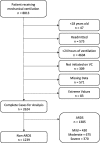Driving pressure is not associated with mortality in mechanically ventilated patients without ARDS
- PMID: 31881909
- PMCID: PMC6935179
- DOI: 10.1186/s13054-019-2698-9
Driving pressure is not associated with mortality in mechanically ventilated patients without ARDS
Abstract
Background: In patients with acute respiratory distress syndrome (ARDS), low tidal volume ventilation has been associated with reduced mortality. Driving pressure (tidal volume normalized to respiratory system compliance) may be an even stronger predictor of ARDS survival than tidal volume. We sought to study whether these associations hold true in acute respiratory failure patients without ARDS.
Methods: This is a retrospectively cohort analysis of mechanically ventilated adult patients admitted to ICUs from 12 hospitals over 2 years. We used natural language processing of chest radiograph reports and data from the electronic medical record to identify patients who had ARDS. We used multivariable logistic regression and generalized linear models to estimate associations between tidal volume, driving pressure, and respiratory system compliance with adjusted 30-day mortality using covariates of Acute Physiology Score (APS), Charlson Comorbidity Index (CCI), age, and PaO2/FiO2 ratio.
Results: We studied 2641 patients; 48% had ARDS (n = 1273). Patients with ARDS had higher mean APS (25 vs. 23, p < .001) but similar CCI (4 vs. 3, p = 0.6) scores. For non-ARDS patients, tidal volume was associated with increased adjusted mortality (OR 1.18 per 1 mL/kg PBW increase in tidal volume, CI 1.04 to 1.35, p = 0.010). We observed no association between driving pressure or respiratory compliance and mortality in patients without ARDS. In ARDS patients, both ΔP (OR1.1, CI 1.06-1.14, p < 0.001) and tidal volume (OR 1.17, CI 1.04-1.31, p = 0.007) were associated with mortality.
Conclusions: In a large retrospective analysis of critically ill non-ARDS patients receiving mechanical ventilation, we found that tidal volume was associated with 30-day mortality, while driving pressure was not.
Keywords: ARDS; Driving pressure; Low tidal volume ventilation; Lung protective ventilation; Respiratory compliance.
Conflict of interest statement
The authors declare that they have no competing interests.
Figures


Comment in
-
Why driving pressure is not associated with the mortality in non-ARDS patients?Crit Care. 2020 Apr 14;24(1):147. doi: 10.1186/s13054-020-02845-2. Crit Care. 2020. PMID: 32290853 Free PMC article. No abstract available.
-
Driving Pressure and Mortality.Am J Respir Crit Care Med. 2022 Jul 1;206(1):105-107. doi: 10.1164/rccm.202102-0376RR. Am J Respir Crit Care Med. 2022. PMID: 35537123 No abstract available.
References
-
- Fan E, Del Sorbo L, Goligher EC, et al. An official American Thoracic Society/European Society of Intensive Care Medicine/Society of Critical Care Medicine clinical practice guideline: mechanical ventilation in adult patients with acute respiratory distress syndrome. Am J Respir Crit Care Med. 2017;195(9):1253–1263. doi: 10.1164/rccm.201703-0548ST. - DOI - PubMed
Publication types
MeSH terms
Grants and funding
LinkOut - more resources
Full Text Sources
Medical
Miscellaneous

